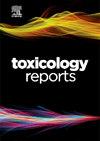Human health risks of PAHs in soil and vegetables from Tiga, Kano State, Nigeria
Q1 Environmental Science
引用次数: 0
Abstract
This study evaluates the concentrations of seventeen polycyclic aromatic hydrocarbons (PAHs) in soil and selected vegetable samples (onions, tomatoes, hot peppers, sweet peppers, and garden eggs) from Tiga agricultural locations in Kano State, Nigeria. Soil samples were collected from ten plots (depth profiles of 0–10 cm, 10–20 cm, and 20–30 cm) and combined at each depth to create composite samples. Additionally, 20 g of each vegetable were collected and divided into fruit, stem, and root components. Standard procedures were used for the extraction and clean-up of PAHs from both soil and vegetable samples, and instrumental analysis was conducted using SHIMADZU GC-MS (GC-17A). PAH levels in soil ranged from 1.20E-02 mg/kg to 3.80E-02 mg/kg, while vegetables showed concentrations from 1.00E-03 mg/kg to 8.90E-02 mg/kg. The 0–10 cm soil samples displayed higher PAH concentrations among all the depths studied, while the vegetables with the highest PAH concentration followed the trend: Onions > Sweet Pepper > Tomatoes > Hot Pepper > Garden Egg. Overall, total PAH concentrations in vegetables exceeded those in soil. Estimated daily PAH doses were below the Tolerable Daily Dose Limit set by FAO, indicating low health risks. Incremental lifetime cancer risk values also fell below US EPA acceptable levels (10E-06), suggesting negligible cancer risk while the hazard index was less than 1, implying no appreciable non-cancer health risks. PAH pollution was attributed to both petrogenic and pyrogenic sources. The findings of this study indicate that under the assessed conditions, the five vegetables evaluated from Tiga pose no significant risk and are considered safe for consumption.
尼日利亚卡诺州提加土壤和蔬菜中多环芳烃的人类健康风险。
本研究评估了尼日利亚卡诺州Tiga农业地区土壤和选定蔬菜样品(洋葱、西红柿、辣椒、甜椒和园蛋)中17种多环芳烃(PAHs)的浓度。在10个样地(深度剖面为0-10 cm、10-20 cm和20-30 cm)采集土壤样品,并在每个深度组合成复合样品。此外,每种蔬菜收集20 g,并将其分为果实、茎和根部分。采用标准程序从土壤和蔬菜样品中提取和清理多环芳烃,并采用SHIMADZU GC-MS (GC-17A)进行仪器分析。土壤中多环芳烃含量为1.20 -02 mg/kg ~ 3.80 -02 mg/kg,蔬菜中多环芳烃含量为1.00 -03 mg/kg ~ 8.90 -02 mg/kg。0 ~ 10 cm土壤样品的多环芳烃浓度在所有研究深度中均较高,而多环芳烃浓度最高的蔬菜依次为:洋葱>甜椒>西红柿>辣椒>花园蛋。总体而言,蔬菜中总多环芳烃浓度高于土壤中。估计每日多环芳烃剂量低于粮农组织规定的每日可耐受剂量限值,表明健康风险较低。终生癌症风险增量值也低于美国环保署可接受水平(10E-06),表明癌症风险可以忽略不计,而危害指数小于1,意味着没有明显的非癌症健康风险。多环芳烃污染主要来源于岩源和热源。本研究结果表明,在评估条件下,Tiga评估的五种蔬菜没有显著风险,可以安全食用。
本文章由计算机程序翻译,如有差异,请以英文原文为准。
求助全文
约1分钟内获得全文
求助全文
来源期刊

Toxicology Reports
Environmental Science-Health, Toxicology and Mutagenesis
CiteScore
7.60
自引率
0.00%
发文量
228
审稿时长
11 weeks
 求助内容:
求助内容: 应助结果提醒方式:
应助结果提醒方式:


